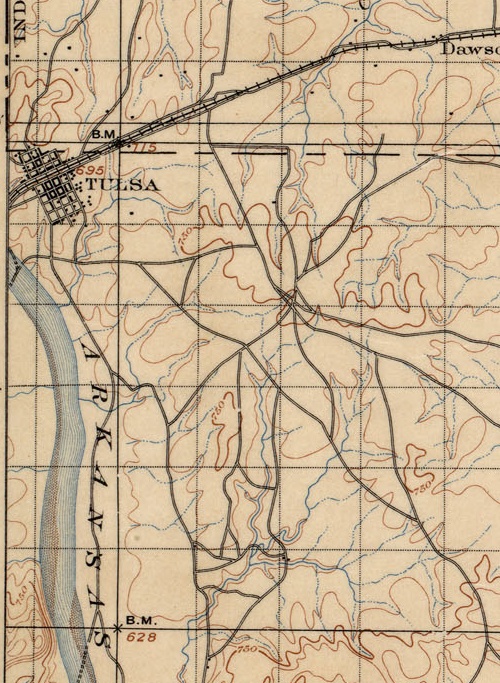The old paths: Historic Oklahoma USGS maps
My apologies for the lapse since my last post. I've been writing, but it's all technical stuff for the gig that pays most of the bills.
While I was at the Coffee House on Cherry Street cranking away on that technical documentation, a customer at the next table, a gentleman named Cecil Cloud, said hello, identified himself as a BatesLine reader, and mentioned a post here about historic maps.
Cecil showed me an amazing collection of U. S. Geological Survey maps of Indian Territory and Oklahoma, online at the University of Texas Perry Castañeda Library Map Collection. Most of the maps predate statehood.
Take a look at this map showing Tulsa as part of the Claremore quadrangle, 1897. What's fascinating is that this is before the Dawes Commission, before land was allotted in quarter-sections to enrolled tribal members, and therefore before the familiar grid of section line roads was established. The townships, ranges, and sections were established, and are shown on the map as a reference grid, making it possible to pinpoint old locations with respect to the present day arterial grid. But the roads on these pre-1900 maps show a network of roads that follows the land, connecting settlements as directly as the terrain will allow.
Here's the section of the map covering what is now midtown and downtown Tulsa.

The grid of early day Tulsa is there, laid out parallel and perpendicular to the Frisco tracks which gave birth to the town. But the grid extends only from modern day Cameron St to 4th St, Cheyenne Ave to Cincinnati Ave. Beyond that, notice the hub of trails just east of present day 21st and Harvard, probably close to the high point that was more recently occupied by a water tower (just east of 21st and Louisville).
Notice too the creeks and streams, long before they were turned into underground storm sewers or rerouted into concrete channels. It's interesting, too, to see the locations of fords and ferries.
Here's an interesting contrast in the neighboring quad to the north, covering Washington, Nowata, and northern Rogers counties:
In just 16 years, the network of trails has been mostly replaced with a grid of section line roads, new towns have been established, and every few miles there's a school. Note the electric railway linking Bartlesville, Tuxedo, and Dewey.
More amazement at the PCL online archive:
1:250,000 USGS maps, including Tulsa maps from 1947 and 1967, covering all of Oklahoma northeast of Jenks. Note that the 1947 city map of Tulsa shows the Tulsa County Fairgrounds within the Tulsa city limits. The 1947 topo map shows the Union Electric Railway connecting Nowata and Coffeyville.
McGraw Electric Railway Manual Maps, 1913: Streetcar maps from nearly everywhere except Oklahoma, including Joplin, Little Rock, Dallas, Fort Worth, San Antonio, and Brooklyn.
0 TrackBacks
Listed below are links to blogs that reference this entry: The old paths: Historic Oklahoma USGS maps.
TrackBack URL for this entry: https://www.batesline.com/cgi-bin/mt/mt-tb.cgi/5623
Thank you Mr. Bates for sharing these and of course, thank you to your new friend. I enjoyed browsing the repository of maps. There are a couple of the old ones that include Oklahoma City.
I will pass them along to Steve & Doug in case they are interested.
Thanks to you and to Cecil for these interesting map links.
The Tulsa street grid on the 1897 USGS Claremore quad is a generalized layout, and it is not drawn accurately to scale. I think the cartographers took some liberties in showing the buildings downtown, because there were not many blocks of continuous street walls then (as indicated on the Sanborn maps of the time).
I'm guessing that present-day Boulder, Main, Boston, Cincinnati, and Detroit are the north-south streets shown on the map, judging by:
1) their positions within Sections 1 and 2 of their township;
2) the fact that Main Street had the most commercial blocks (although not as many as are indicated on the map); and
3) the streets drawn on a USGS fractional township map from the 1890s, which appear to be the same north-south streets.
The scale of the USGS fractional township map is 1:31,680. It also exaggerated the blocks of commercial buildings, but not as much as the quad map. And I think there were some surveying or field recording problems with the east-west streets on both the fractional township map and the quad map, because those don't appear to match the Sanborn maps well at all. The southernmost street on both maps is positioned approximately where Eighth Street is now.
In general (with some exceptions), Tulsa's street grid is laid out on 380 foot centers in each direction. On the quad map, Tulsa's grid is shown at approximately 550 feet by 600 feet. Claremore's grid, depicted at approximately 900 foot centers in each direction, is even more out of scale than Tulsa's. The size of Catoosa's grid appears to be the most accurate of the three towns, with the streets perpendicular to the railroad drawn approximately 410 feet center to center.
I noticed the roads parallel to and on each side of the Frisco railroad tracks in Tulsa are also shown on the early Sanborn maps, but not on later editions.
Was Owasso once called Turley? Or is that an error?
This post is absolutely amazing! I will share it with my fellow land surveyors in Oklahoma on our support group...thanks for sharing all of this valuable information!
THANK YOU for sharing these maps!
I am from the Oologah, OK area and I thought I'd point out the '67 Tulsa Map apparently shows Oologah Lake, the new alignment of highway 88 between Claremore and Oologah, and Winganon crossing over Oologah lake all before they were completed, which to me was interesting.
That new alignment of 88 was one I frequently traveled between our house in far east Tulsa (near Catoosa) to my grandparents' house in Nowata, starting in 1969.